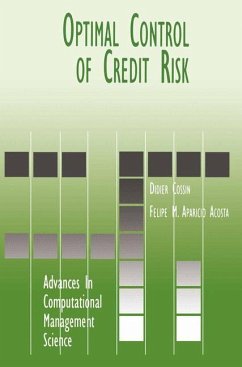
Modeling Credit Risk and Pricing Credit Derivatives
Versandkostenfrei!
Versandfertig in 1-2 Wochen
58,00 €
inkl. MwSt.

PAYBACK Punkte
0 °P sammeln!
Diploma Thesis from the year 2001 in the subject Business economics - Investment and Finance, grade: 1,0, University of Innsbruck (Architektur/Bauingenieurswesen), language: English, abstract: Inhaltsangabe:Abstract:Banks are financial intermediaries originating loans and consequently facing credit risk. Credit risk can be defined as the risk of losses caused by the default or by the deterioration in credit quality of a borrower. Default occurs when a borrower cannot meet his key financial obligations to pay principal and interest.Banks increasingly recognize the need to measure and manage the...
Diploma Thesis from the year 2001 in the subject Business economics - Investment and Finance, grade: 1,0, University of Innsbruck (Architektur/Bauingenieurswesen), language: English, abstract: Inhaltsangabe:Abstract:
Banks are financial intermediaries originating loans and consequently facing credit risk. Credit risk can be defined as the risk of losses caused by the default or by the deterioration in credit quality of a borrower. Default occurs when a borrower cannot meet his key financial obligations to pay principal and interest.
Banks increasingly recognize the need to measure and manage the credit risk of the loans they have originated not only on a loan-by-loan basis but also on a portfolio basis. A precondition for diversification after the origination of the loans is their transferability. But as it is wellknown transferring credit risk of loans is difficult due to severe adverse selection and moral hazard problems. That is why the use of existing tools like loan sales has not been very successful in transferring the credit risk on a broad scale. However, in recent years, the development of markets for credit securitization and credit derivatives has provided new tools for managing credit risk.
Credit derivatives are often described as synthetic loans which reflects only too narrowly their common use and enormous potential. More broadly defined credit derivatives are sophisticated financial instruments that enable the unbundling and intermediation of credit.
A risk seller, which is the party seeking credit risk protection, may want to reduce exposures while maintaining relationships that may be endangered by selling their loans, reduce or diversify illiquid exposures, or reduce exposures while avoiding adverse tax or accounting treatment. A risk buyer, the party assuming credit risk, may want to diversify credit exposures, get access to credit markets which are otherwise restricted by corporate statute or off-limits by regulation, or simply exploit arbitrage pricing discrepancies, for example resulting from perceived mispricing between bank loans and subordinated debt of the same issuer.
The pricing and management of credit derivatives requires more sophisticated credit risk models. With the advent of the market-based models the mathematical modeling of the pure interest-rate risk in the bond market is coming closer to a generally accepted benchmark. Of the remaining risk components in the bond market, credit risk is the largest unresolved modeling problem.
The valuation of credit derivatives changed the focus of many credit risk models. Instead of developing a pricing framework which yields the fair prices for defaultable bonds, now these bonds are to be taken as input to derive prices for more exotic derivative instruments. Therefore, models had to be developed that had this degree of flexibility.
The thesis for diploma (in the rest of this paper simply called thesis) starts with a short description of the credit derivatives' place in the credit risk management. Then it proceeds by outlining the basic forms of credit derivatives, their applications, and their contract elements. Chapter 4 gives a first impression of the two common pricing frameworks, whereas chapter 5 describes the Duffie-Singleton approach in more detail. Chapter 6 applies this framework and examines the importance of the different parameters on the outcomes of the simulation. Finally, chapter 7 gives examples for the valuation of creditrisky securities.
Inhaltsverzeichnis:Table of Contents:
1.INTRODUCTION4
2.CREDIT RISK MANAGEMENT6
2.1Credit Risk versus Market Risk6
2.2Methods of Credit Risk Management7
2.2.1Risk Transfer in the Cash Market8
2.2.2Risk Transfer with Credit Derivatives8
2.2.3Regulatory Treatment of Credit Derivatives8
3.CREDIT DERIVATIVES - STRUCTURES AND APPLICATIONS10
3.1Definition10
3.2...
Banks are financial intermediaries originating loans and consequently facing credit risk. Credit risk can be defined as the risk of losses caused by the default or by the deterioration in credit quality of a borrower. Default occurs when a borrower cannot meet his key financial obligations to pay principal and interest.
Banks increasingly recognize the need to measure and manage the credit risk of the loans they have originated not only on a loan-by-loan basis but also on a portfolio basis. A precondition for diversification after the origination of the loans is their transferability. But as it is wellknown transferring credit risk of loans is difficult due to severe adverse selection and moral hazard problems. That is why the use of existing tools like loan sales has not been very successful in transferring the credit risk on a broad scale. However, in recent years, the development of markets for credit securitization and credit derivatives has provided new tools for managing credit risk.
Credit derivatives are often described as synthetic loans which reflects only too narrowly their common use and enormous potential. More broadly defined credit derivatives are sophisticated financial instruments that enable the unbundling and intermediation of credit.
A risk seller, which is the party seeking credit risk protection, may want to reduce exposures while maintaining relationships that may be endangered by selling their loans, reduce or diversify illiquid exposures, or reduce exposures while avoiding adverse tax or accounting treatment. A risk buyer, the party assuming credit risk, may want to diversify credit exposures, get access to credit markets which are otherwise restricted by corporate statute or off-limits by regulation, or simply exploit arbitrage pricing discrepancies, for example resulting from perceived mispricing between bank loans and subordinated debt of the same issuer.
The pricing and management of credit derivatives requires more sophisticated credit risk models. With the advent of the market-based models the mathematical modeling of the pure interest-rate risk in the bond market is coming closer to a generally accepted benchmark. Of the remaining risk components in the bond market, credit risk is the largest unresolved modeling problem.
The valuation of credit derivatives changed the focus of many credit risk models. Instead of developing a pricing framework which yields the fair prices for defaultable bonds, now these bonds are to be taken as input to derive prices for more exotic derivative instruments. Therefore, models had to be developed that had this degree of flexibility.
The thesis for diploma (in the rest of this paper simply called thesis) starts with a short description of the credit derivatives' place in the credit risk management. Then it proceeds by outlining the basic forms of credit derivatives, their applications, and their contract elements. Chapter 4 gives a first impression of the two common pricing frameworks, whereas chapter 5 describes the Duffie-Singleton approach in more detail. Chapter 6 applies this framework and examines the importance of the different parameters on the outcomes of the simulation. Finally, chapter 7 gives examples for the valuation of creditrisky securities.
Inhaltsverzeichnis:Table of Contents:
1.INTRODUCTION4
2.CREDIT RISK MANAGEMENT6
2.1Credit Risk versus Market Risk6
2.2Methods of Credit Risk Management7
2.2.1Risk Transfer in the Cash Market8
2.2.2Risk Transfer with Credit Derivatives8
2.2.3Regulatory Treatment of Credit Derivatives8
3.CREDIT DERIVATIVES - STRUCTURES AND APPLICATIONS10
3.1Definition10
3.2...














